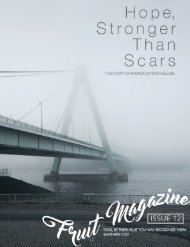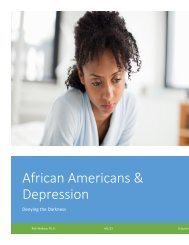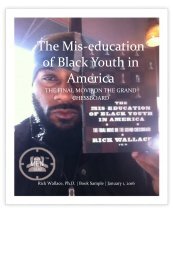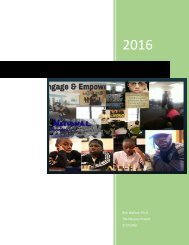Addressing African American Inner-City Violence
Looking at the causality and viable engagement options for effectively dealing with African American inner-city violence, especially as it pertains to African American adolescent males.
Looking at the causality and viable engagement options for effectively dealing with African American inner-city violence, especially as it pertains to African American adolescent males.
Create successful ePaper yourself
Turn your PDF publications into a flip-book with our unique Google optimized e-Paper software.
2016<br />
<strong>African</strong> <strong>American</strong> <strong>Inner</strong>-city <strong>Violence</strong><br />
Rick Wallace, Ph.D.<br />
The Odyssey Project<br />
6/21/2016
<strong>Addressing</strong> <strong>African</strong> <strong>American</strong> <strong>Inner</strong>-city<br />
<strong>Violence</strong> through Racial Socialization<br />
By<br />
Dr. Rick Wallace, Ph.D.<br />
2016 Copyright © The Odyssey Project Research Department
<strong>Addressing</strong> <strong>African</strong> <strong>American</strong> <strong>Inner</strong>-city <strong>Violence</strong> through Racial Socialization<br />
The multitudinous, enigmatic issues that are plaguing the Black collective have been welldocumented<br />
in books, research, articles and academic papers, and one of the most polarizing<br />
topics is what is commonly referred to by mainstream media as “black on black” crime. While I<br />
have played an integral role in exposing the myth of black on black crime as an exclusive<br />
phenomenon, I must still acknowledge the existence of intraracial hostility and fratricide as a<br />
serious threat to the idea of black empowerment. The fact that the vast majority of violent crimes<br />
against blacks are committed by other blacks is nothing unusual. It is a natural part of the social<br />
construct. People normally commit violent acts against those they are most exposed to within<br />
their enclave. In fact, 84 percent of homicides against Whites are committed by other whites, and<br />
this number is pretty consistent throughout all racial makeups.<br />
Support the inner-city work of The Odyssey Project!<br />
Yet, the problem still remains that Blacks, especially adolescents and young adults are killing<br />
each other at an alarming rate. With the Black male population suffering a major hit from mass
incarceration, we cannot afford the perpetual occurrence of young black males killing one<br />
another — not to mention innocent bystanders.<br />
I have invested a substantial amount of time in understanding the causality of the violence in the<br />
inner city. What I have found is that there are a number of primary elements involved. At the<br />
core, there are common influencers, such as being the victim of violence, witnessing violence,<br />
and urban hassle. Each of these influencers serve to increase the proclivity of <strong>African</strong> <strong>American</strong><br />
adolescent males to become violent. However, there are two elements that are viewed as the<br />
most prevalent influencers — the feeling of being disrespected and the lack of proper racial<br />
socialization (DeGruy, Brennan, & Briggs, 2009). While the manner in which “respect”<br />
influences the development of a prosocial attitude in <strong>African</strong> <strong>American</strong> youth is immensely<br />
important, and most likely the most powerful influence in the increased risk of violence, it is the<br />
development of a universal racial socialization process, introduced through a “rite of passage”<br />
model, that will have the greatest initial impact.<br />
Get your signed copy of The Mis-education of Black Youth in America!<br />
Racial socialization is defined as specific verbal and non-verbal messages that are transmitted to<br />
younger generations for the development of values, attitudes, behaviors, and beliefs regarding<br />
the meaning and significance of race and racial stratification, intergroup interactions, and<br />
personal and group identity.<br />
Racial socialization is receiving increased attention in the world of scientific research, primarily<br />
due to the fact that there is growing empirical and pragmatic evidence to support the idea that it<br />
is a protective developmental process, especially when it comes to <strong>African</strong> <strong>American</strong> families.<br />
Not only can proper rational socialization of <strong>African</strong> <strong>American</strong> males reduce the need to
discipline children, it can also increase the effect of disciplinary action, when it is deemed<br />
necessary (Rodriguez, McKay, & Bannon, 2009).<br />
While racial socialization can enhance the ability of Blacks to effectively parent their children, it<br />
has the capacity to do so much more. Proper racial socialization can prepare children to adjust to<br />
the unique demands associated with being black — helping them develop a positive self-concept.<br />
Additionally, when <strong>African</strong> <strong>American</strong> children are faced with discrimination and racism, they<br />
will have the ability to identify with the prosocial attitude and pride of belonging to the Black<br />
race, using this identity as a coping strategy (Boykin & Toms, 1985; Peters, 1985; Ward, 2000).<br />
Theory and research on racial socialization as a part of the parenting process in managing the<br />
behavior of children, and studies focused on behavioral problems have developed separately;<br />
however, recent research has gravitated towards examining how certain aspects of racial<br />
socialization relate to impacting problem behaviors, including violence (Caughy, O'Camp,<br />
Randolf, & Nickerson, 2002; Stenvenson, Herrero-Taylor, Cameron, & Davis, 2002)<br />
Racial socialization is the primary vehicle of cultural transmission for <strong>African</strong> <strong>American</strong> families<br />
that are steeped in the tradition of oppressive resistance — involving actions and conversations<br />
that communicate to our children how to survive and thrive with dignity, despite the incessant<br />
hostility by those in their periphery (Stevenson, Davis, & Abdul-Kabir, 2001).<br />
One thing that we have done as a racial group that has limited our effectiveness in preparing our<br />
children, is that we fail to see beyond the surface of the symptomatic issues that plague our<br />
communities. Additionally, we fail to see education as a tool of empowerment. We see the<br />
violence, the dropout rates and higher incarceration rates, but it has become easier for us to<br />
accept the narrative provided to us by the mainstream media than it is to examine them for<br />
ourselves, and to develop solutions that will prove efficacious in achieving the progressive goals<br />
we set. The answers are there, but we cannot holistically address the problem by only seeing the<br />
symptoms.<br />
In essence, the violence that we are experiencing at record levels within our communities are the<br />
results of our failure to properly socialize and educate our children. We have not prepared them<br />
to go out and compete in a world that is innately hostile toward them. We have not created<br />
systems that provide the support necessary for them to thrive without acquiescing to the demands<br />
of those who operate in a dynamic that is antithetical to their survival and success.<br />
It is time that we invest ourselves in effectively engaging our problems, not on the surface, but at<br />
the origin. ~ Dr. Rick Wallace, Ph.D.<br />
Bibliography<br />
Boykin, A., & Toms, F. (1985). Black Child Socialization: A Conceptual Framework. Thousand<br />
Oaks, CA: Sage Publications.
Caughy, M., O'Camp, P., Randolf, S., & Nickerson, K. (2002). The Influence of Raical<br />
Socialization Practices on the Cognitive and Behavioral Competence of <strong>African</strong><br />
<strong>American</strong> Preschoolers. Journal of Child Development.<br />
DeGruy, J., Brennan, E. M., & Briggs, H. E. (2009). The <strong>African</strong> <strong>American</strong> Adolescence<br />
Respect Scale: The Measure of Prosocial Attitude. The University of Portland, 1-3.<br />
Peters, M. (1985). Ethnic Socialization of Young Black Children. Beverly Hills, CA: Sage<br />
Publications.<br />
Rodriguez, J., McKay, M. M., & Bannon, W. M. (2009). The Role of Racial Socialization in<br />
Relation to Parenting Practices and Youth Behavior: An Exploratory Analysis. National<br />
Institute of Health.<br />
Stenvenson, H., Herrero-Taylor, T., Cameron, R., & Davis, G. (2002). Mitigating Instigation:<br />
Cultural Phenomenological Influences of Anger and Fighting Among "Big-Boned" and<br />
"Baby-faced" <strong>African</strong> <strong>American</strong> Youth. Journal of Youth and Adolescence.<br />
Stevenson, H., Davis, G., & Abdul-Kabir, S. (2001). Stickin to, Watchin Over and Gettin With:<br />
An <strong>African</strong> <strong>American</strong> Parent's Guide to Discipline. San Francisco: Josey-Bass.<br />
Ward, J. (2000). The Skin We're In: Teaching Our Teens to be Emotionally Strong, Socially<br />
Smart and Spiritually Connected. New York: Simon and Schuster.

















